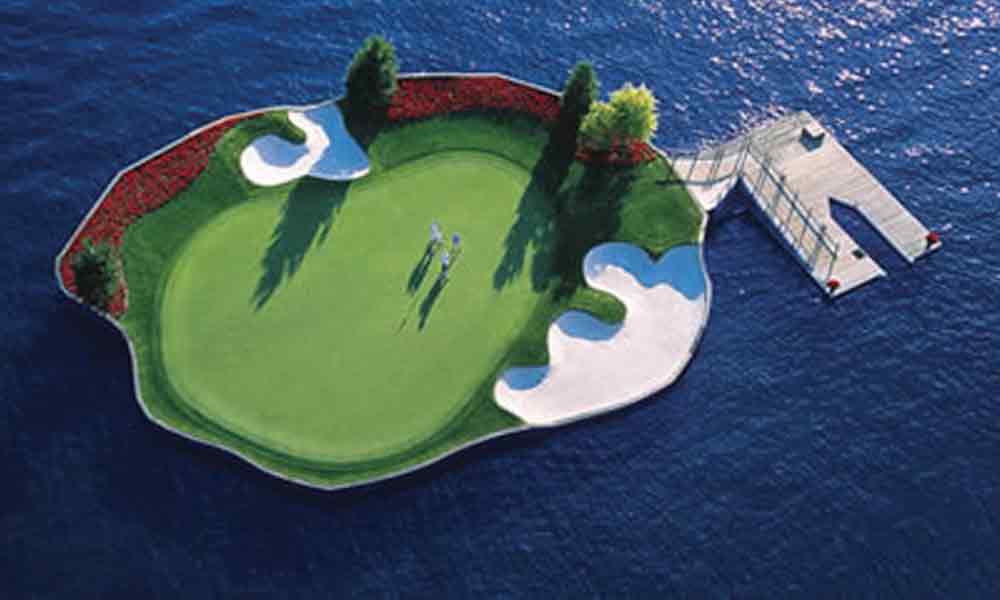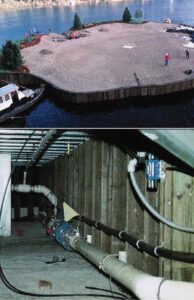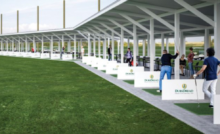The Floating Golf Green at Coeur D’Alene – Still a Wonder of the Golf World


Coeur D’Alene Resort,
Take a vacation at Coeur D’Alene Resort, tucked cozily by the Idaho lake of the same name, and you will remember it for the rest of your life.
“I’ve been there!” gushed one of my friends who saw pictures over my shoulder as I wrote this article. “The water is that blue! The grass is that green! The sky is that sunny!”
His enthusiasm is echoed almost universally. Forest-fragrant air, dappled sunshine on azure waves, airy rooms with tall ceilings, a galaxy of sporting activities, impeccable service: since it opened in 1965, every superlative you’ve heard about Coeur D’Alene understates the case, and anyone who made the trek to this remote, yet idyllic Pacific Northwest retreat has declared it Heaven on Earth. Take your spouse there for a week, and they owe you for a decade.


Coeur D’Alene was a favorite of Jet Setters, Hollywood, and Main Street alike even before the golf course opened in 1991. But once it came online, golf became the premiere attraction, primarily because Coeur D’Alene is home to a hole unique in golf – the par-3 14th with its world-famous “Floating Green” – an iridescent emerald island set in a sparkling sapphire sea.
You’ve seen island greens before, most notably on the PGA Tour at Sawgrass, Scottsdale, and PGA West. But where each of those has a walkway you can take to the green by foot. Coeur D’Alene’s is a true island – as in you need to take a boat to get to the green…it’s either that or swim.
Now here’s the best part: even though it weighs a gargantuan 5.5 million pounds (or 2,200 tons, if you prefer) and comprises a grand total of 15,000 square feet, the entire green complex really does float – it’s connected to the mainland by an underwater system of pulleys that move the green around the lake.
“It can play anywhere from 90-220 yards, depending on your tee box,” explained Scott Miller, the golf architect who designed the course. “The green is held in place by four cables; two attached to enormous ship’s anchors placed in the bottom of the lake, about 20-25 feet deep at that point. Two more cables lead to the land and move the greenback and forth.”
Floating Golf Green Design
The idea was resort owner and developer Duane Hagadone’s. While working out routings with Scott Miller, then a young architect fresh off a successful run as one of Jack Nicklaus’s design associates, Hagadone looked out at the little island which, at the time, housed a logging mill.
“Why can’t that be a green? A moveable floating green?” he asked everyone. “You’re talkin’ crazy!” they’d all respond. According to legend, even Nicklaus told Miller to try to talk Hagadone out of it.
You can’t really blame Nicklaus, Miller, or anyone else for their skepticism. Meddling, tinkering developers/owners/greens chairman are usually cautionary tales. For every Eric Bergstol who beat the odds and did excellent design work even though it’s not his primary gig, there are dozens of Bob Langs who made laughably bad gaffes. Usually, the rule of thumb is that the money may remain in the room so long it remains silent and pays attention.
But Hagadone was more far-sighted than any experts gave him credit for. What was dismissed as a gimmick became not merely a feature attraction, but the most recognizable and beloved icon of the resort. Yes, the entire golf course is excellent – pristine conditioning, an idyllic natural setting, and a course-wide and welcoming enough that you’ll have a good chance of shooting better than your handicap, but 14 is the showstopper, a centerpiece.
“It’s built like a big ship,” explained Miller. “The entire green complex is comprised of concrete cells that fit together like Legos or Tetris pieces. (Many bridges in the Pacific Northwest are assembled the same way.) Each cell is about three feet wide by three feet high by six feet long. They are hollow in the middle, filled with Styrofoam, which creates buoyancy, and if they crack they won’t take on water.”
Once assembled, the total height of the green was 16 feet – 12 feet under the water, and four feet above. The whole green complex is 35 yards deep and 55 yards across. Besides 6,500 square feet of putting surface maintained to stimp at about 9.5-10, the green complex features two bunkers, colorful flower beds, a port to moor the boat and a swath of rough.
It’s a seven-minute ride from the pier set by the lakeside tee box to moor at the edge of the long enough to forget that you were one of 28,000 golf balls yearly that fall into – possibly – the most beautiful lake in America.
There’s even a digital monitor with an LCD readout of the day’s distance. In my late afternoon round, they actually put the green in motion so I could count down to perfect 8-iron distance…140…139…138…137…136…FIRE!
Now there are 28,001 balls in the water.
Upon reaching the green, you get a 360-degree, panoramic view of the lake. Hang gliders sail past, kaleidoscopic-patterned hot air balloons float serenely by and water skiers wave at you before face planting and realizing they better pay attention to the boat, not the golfers. It’s a surreal setting for golf. Yet under your feet is the command center – the control point for what was, at the time, the most expensive green ever built. Huge winches wind the cables and a dial with settings marked at five-yard intervals position the green. It moves about four yards per minute, but it’s much more than just a “dial and go” operation.
“Nothing is easy about it,” confided Tom Hicks, who until this September served a long tenure as head superintendent. “The cables are substantial – 7/8ths of an inch thick, and we inspect them twice annually. Once we had to replace them, and it was a very large undertaking. We also have to grease the bearings and winches. Preventative maintenance is critical. After all, this is why people come.”
It was as difficult an undertaking as it sounds, and when things went wrong, they went completely haywire.
“When we built it in 1990, for access reasons, we had to do it in a bay 3-4 miles from the lake and then tow it into position. The crane that placed the cells could only reach so far, so from time t time we had to turn the assembled pieces with tug boats,” Miller recalls chuckling. “The first time they turned it, they got a little too eager not realizing that when you get something that heavy moving it takes a lot to get it stopped. We were only going to spin it 180 degrees, however, it started spinning out of control and it took four tugboats 15 minutes to get it stopped and back into place.”
Moreover, everything has to be taken out there by boat – walking mowers, top dressers, aerifiers, sand for the bunkers, flower deliveries, everything.
“The owner had a vision, and his ideas were not popular; he went against the grain, but he wanted fun and enjoyable, and that’s what he got,” stated Hicks. “Word of mouth is a big piece of advertisement. He said people would come back, and they did.”
When not reporting live from major sports championships or researching golf courses for design, value, and excitement, multiple award-winning sportswriter Jay Flemma is an entertainment, Internet, trademark, and banking lawyer from New York. His clients have been nominated for Grammy and Emmy awards, won a Sundance Film Festival Best Director award, performed on stage and screen, and designed pop art for museums and collectors. Twitter @JayGolfUSA
Recent Posts
Memphis Country Club: A Golfer’s Study in Precision and Tradition
If you have ever teed it up at Memphis Country Club, you know this isn’t…
Foley Company attains GCSAA Silver Partner Status
Foley Company, a leader in turf equipment innovation and technology, affirms its support of the…
Harrell’s continues longstanding support of the GCSAA Foundation
Harrell’s LLC, a leading distributor of customized agronomic products for turfgrass since 1941, has donated…
City of Orlando Announces New State-of-the-Art Driving Range at Dubsdread Golf Course
The City of Orlando is excited to announce the construction of a brand-new, state-of-the-art driving…
Discover Puerto Rico for Great Golf Trips and After-Round Activities, Amenities
Golfers cannot live by the game alone which is why Puerto Rico provides the perfect…
Q&A with a Multi-talented Golf Course Architect – Part 2: Making the Rounds – Installment 39
This column features recollections of the author’s 37 years as a golf writer. These installments…


